Data Analysis and Forecasting of Bill Payments
VerifiedAdded on 2023/01/12
|12
|1451
|90
AI Summary
This report focuses on data analysis and forecasting of bill payments for different months. It includes calculations of mean, mode, median, range, and standard deviation, as well as the use of linear forecasting model. The report concludes with the forecasted expenses for month 12 and 14.
Contribute Materials
Your contribution can guide someone’s learning journey. Share your
documents today.
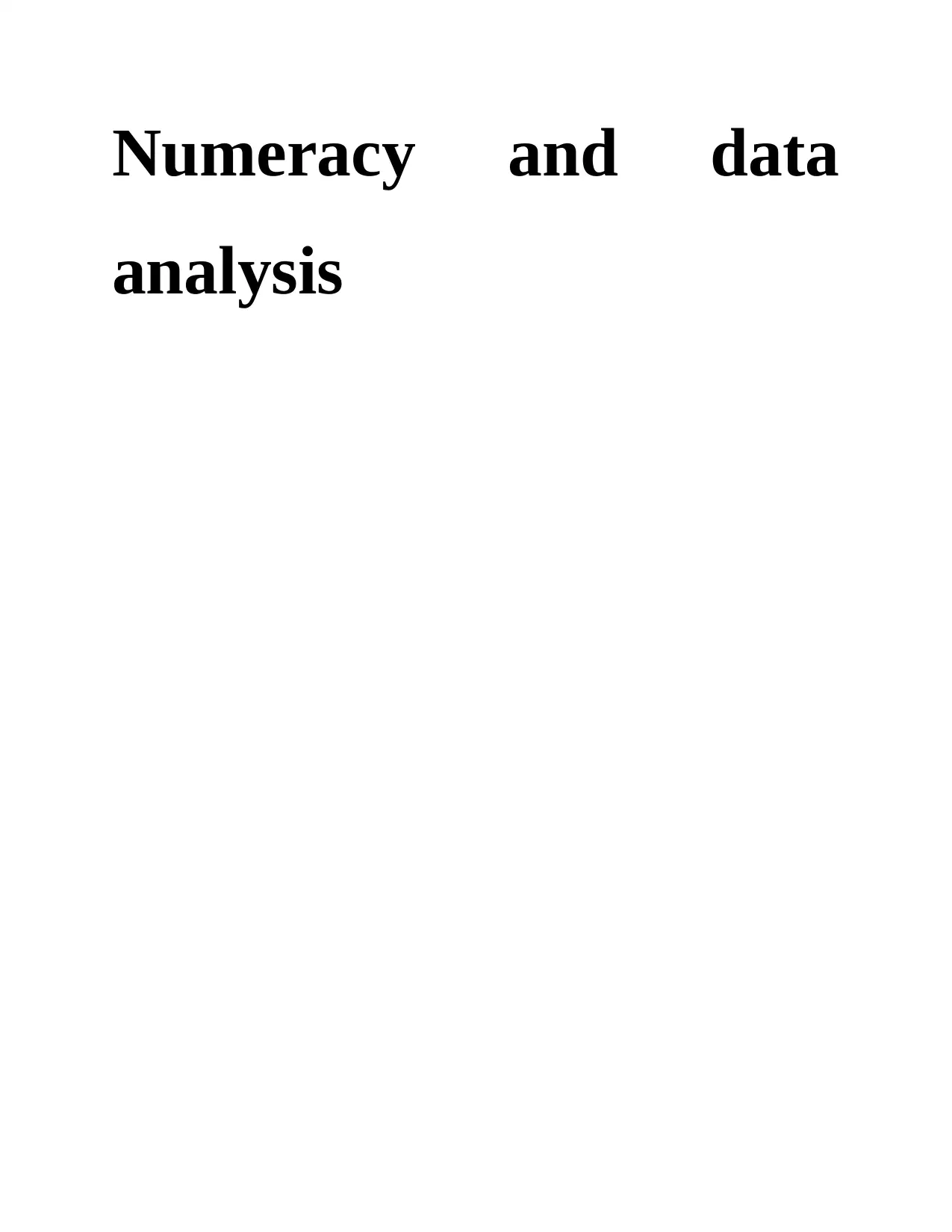
Numeracy and data
analysis
analysis
Secure Best Marks with AI Grader
Need help grading? Try our AI Grader for instant feedback on your assignments.
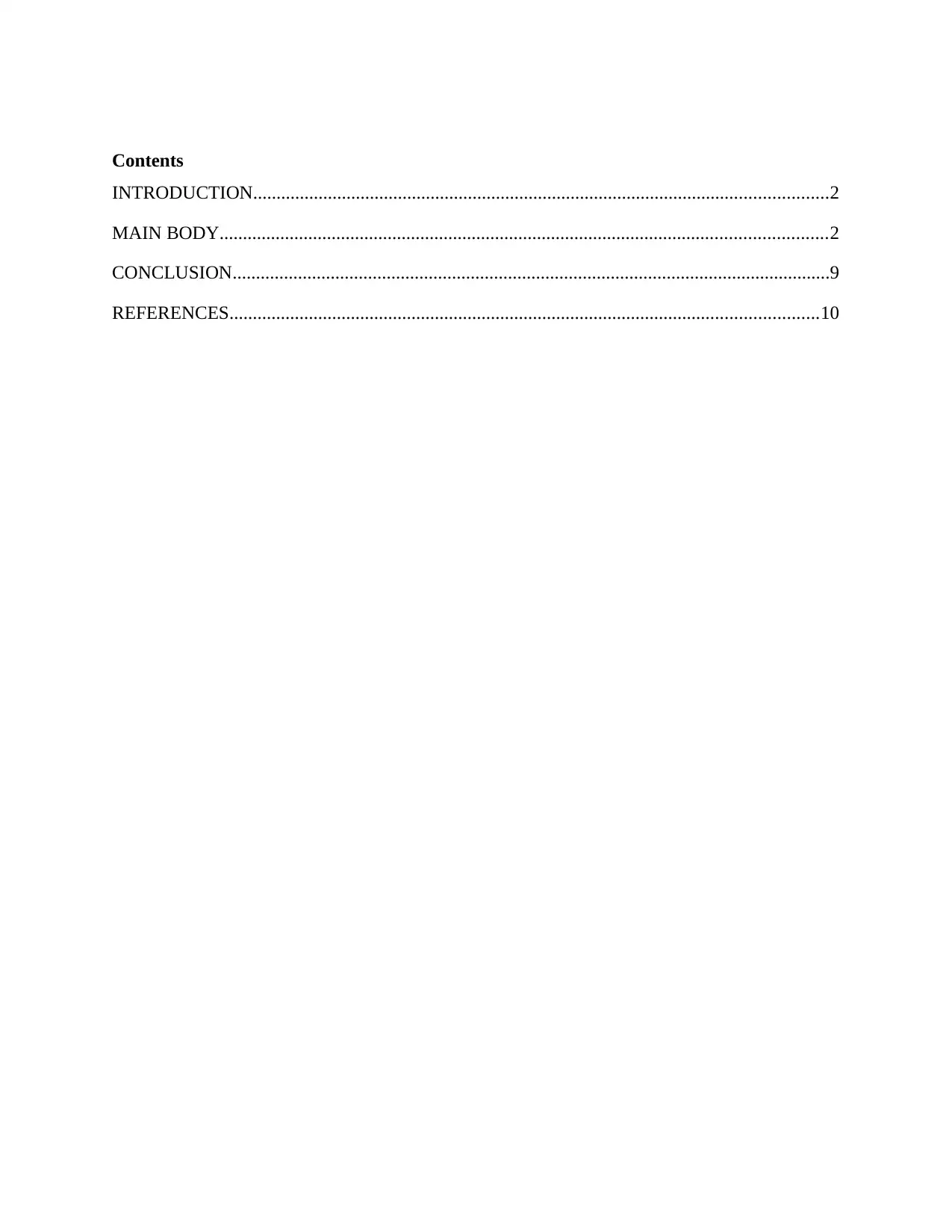
Contents
INTRODUCTION...........................................................................................................................2
MAIN BODY..................................................................................................................................2
CONCLUSION................................................................................................................................9
REFERENCES..............................................................................................................................10
INTRODUCTION...........................................................................................................................2
MAIN BODY..................................................................................................................................2
CONCLUSION................................................................................................................................9
REFERENCES..............................................................................................................................10
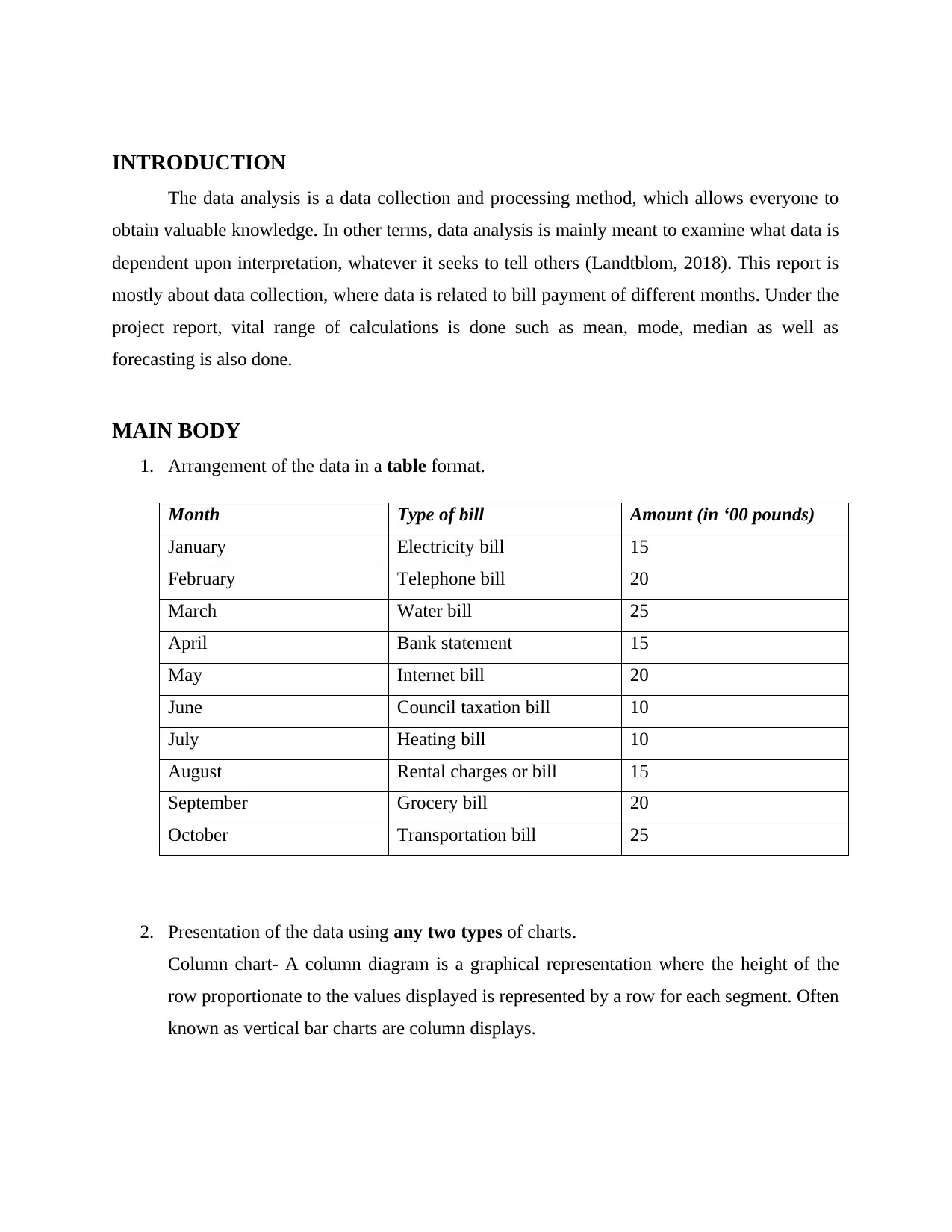
INTRODUCTION
The data analysis is a data collection and processing method, which allows everyone to
obtain valuable knowledge. In other terms, data analysis is mainly meant to examine what data is
dependent upon interpretation, whatever it seeks to tell others (Landtblom, 2018). This report is
mostly about data collection, where data is related to bill payment of different months. Under the
project report, vital range of calculations is done such as mean, mode, median as well as
forecasting is also done.
MAIN BODY
1. Arrangement of the data in a table format.
Month Type of bill Amount (in ‘00 pounds)
January Electricity bill 15
February Telephone bill 20
March Water bill 25
April Bank statement 15
May Internet bill 20
June Council taxation bill 10
July Heating bill 10
August Rental charges or bill 15
September Grocery bill 20
October Transportation bill 25
2. Presentation of the data using any two types of charts.
Column chart- A column diagram is a graphical representation where the height of the
row proportionate to the values displayed is represented by a row for each segment. Often
known as vertical bar charts are column displays.
The data analysis is a data collection and processing method, which allows everyone to
obtain valuable knowledge. In other terms, data analysis is mainly meant to examine what data is
dependent upon interpretation, whatever it seeks to tell others (Landtblom, 2018). This report is
mostly about data collection, where data is related to bill payment of different months. Under the
project report, vital range of calculations is done such as mean, mode, median as well as
forecasting is also done.
MAIN BODY
1. Arrangement of the data in a table format.
Month Type of bill Amount (in ‘00 pounds)
January Electricity bill 15
February Telephone bill 20
March Water bill 25
April Bank statement 15
May Internet bill 20
June Council taxation bill 10
July Heating bill 10
August Rental charges or bill 15
September Grocery bill 20
October Transportation bill 25
2. Presentation of the data using any two types of charts.
Column chart- A column diagram is a graphical representation where the height of the
row proportionate to the values displayed is represented by a row for each segment. Often
known as vertical bar charts are column displays.
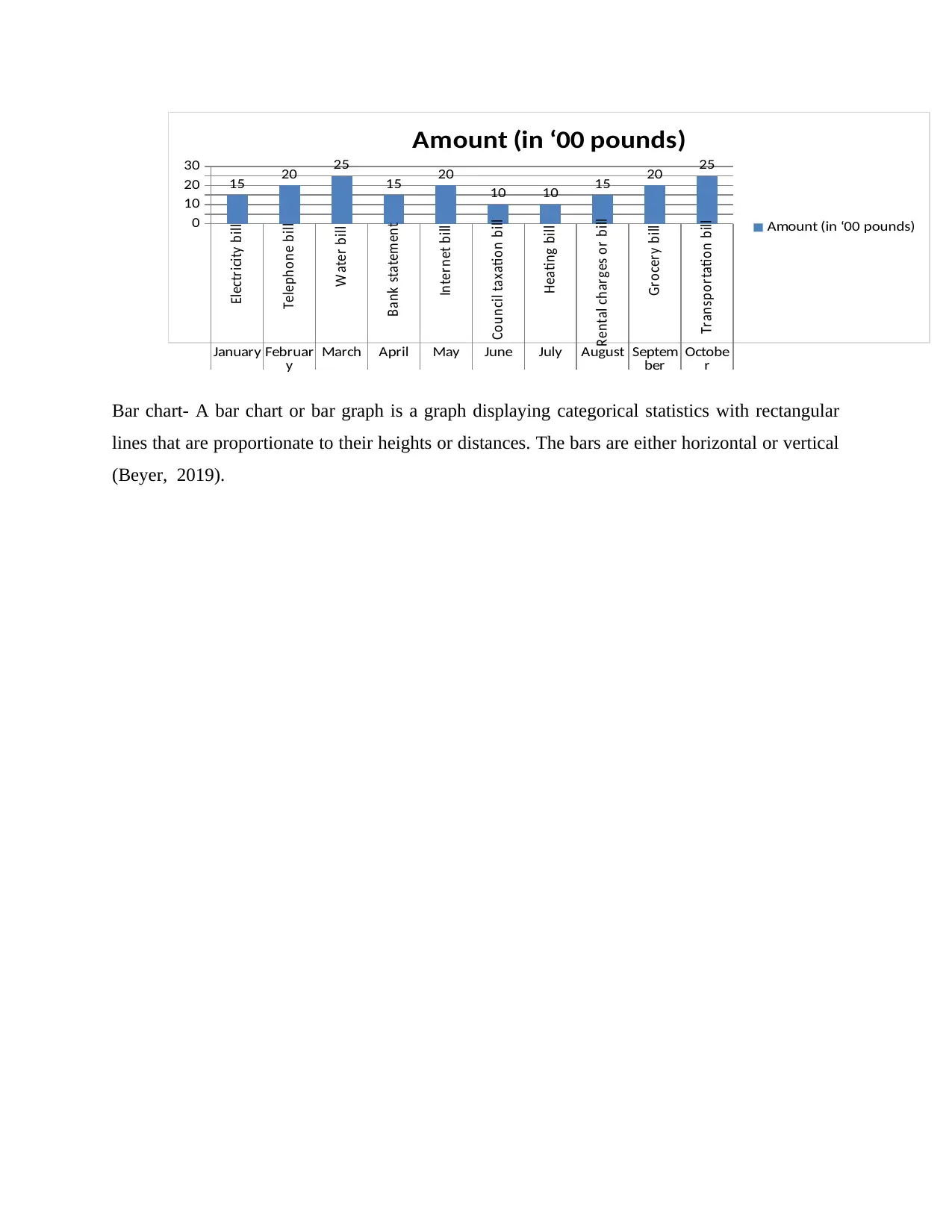
Electricity bill
Telephone bill
W ater bill
Bank statement
Internet bill
Council taxation bill
Heating bill
Rental charges or bill
Grocery bill
Transportation bill
January Februar
y March April May June July August Septem
ber Octobe
r
0
10
20
30
15 20 25
15 20
10 10 15 20 25
Amount (in ‘00 pounds)
Amount (in ‘00 pounds)
Bar chart- A bar chart or bar graph is a graph displaying categorical statistics with rectangular
lines that are proportionate to their heights or distances. The bars are either horizontal or vertical
(Beyer, 2019).
Telephone bill
W ater bill
Bank statement
Internet bill
Council taxation bill
Heating bill
Rental charges or bill
Grocery bill
Transportation bill
January Februar
y March April May June July August Septem
ber Octobe
r
0
10
20
30
15 20 25
15 20
10 10 15 20 25
Amount (in ‘00 pounds)
Amount (in ‘00 pounds)
Bar chart- A bar chart or bar graph is a graph displaying categorical statistics with rectangular
lines that are proportionate to their heights or distances. The bars are either horizontal or vertical
(Beyer, 2019).
Secure Best Marks with AI Grader
Need help grading? Try our AI Grader for instant feedback on your assignments.
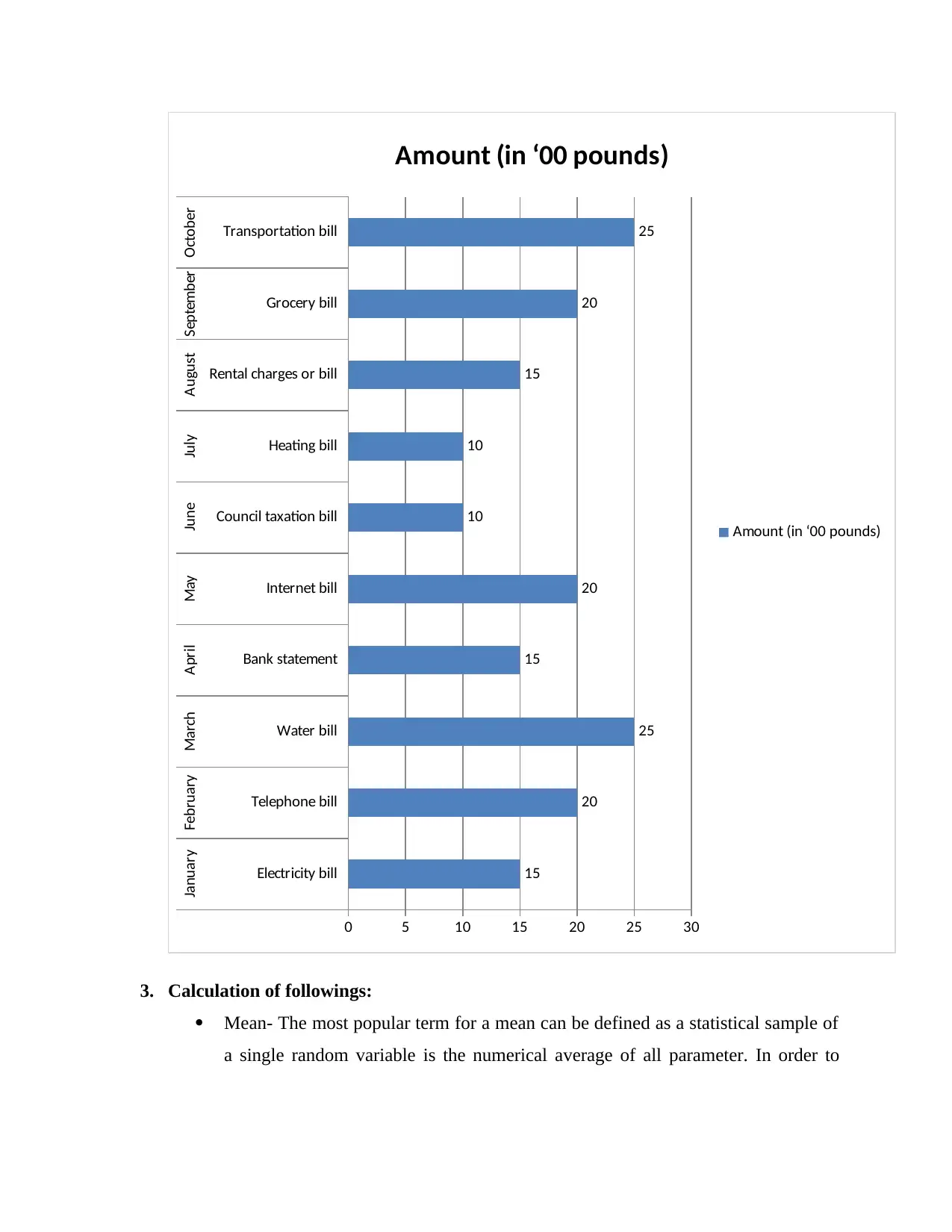
Electricity bill
Telephone bill
Water bill
Bank statement
Internet bill
Council taxation bill
Heating bill
Rental charges or bill
Grocery bill
Transportation bill
January February March April May June July August September October
0 5 10 15 20 25 30
15
20
25
15
20
10
10
15
20
25
Amount (in ‘00 pounds)
Amount (in ‘00 pounds)
3. Calculation of followings:
Mean- The most popular term for a mean can be defined as a statistical sample of
a single random variable is the numerical average of all parameter. In order to
Telephone bill
Water bill
Bank statement
Internet bill
Council taxation bill
Heating bill
Rental charges or bill
Grocery bill
Transportation bill
January February March April May June July August September October
0 5 10 15 20 25 30
15
20
25
15
20
10
10
15
20
25
Amount (in ‘00 pounds)
Amount (in ‘00 pounds)
3. Calculation of followings:
Mean- The most popular term for a mean can be defined as a statistical sample of
a single random variable is the numerical average of all parameter. In order to
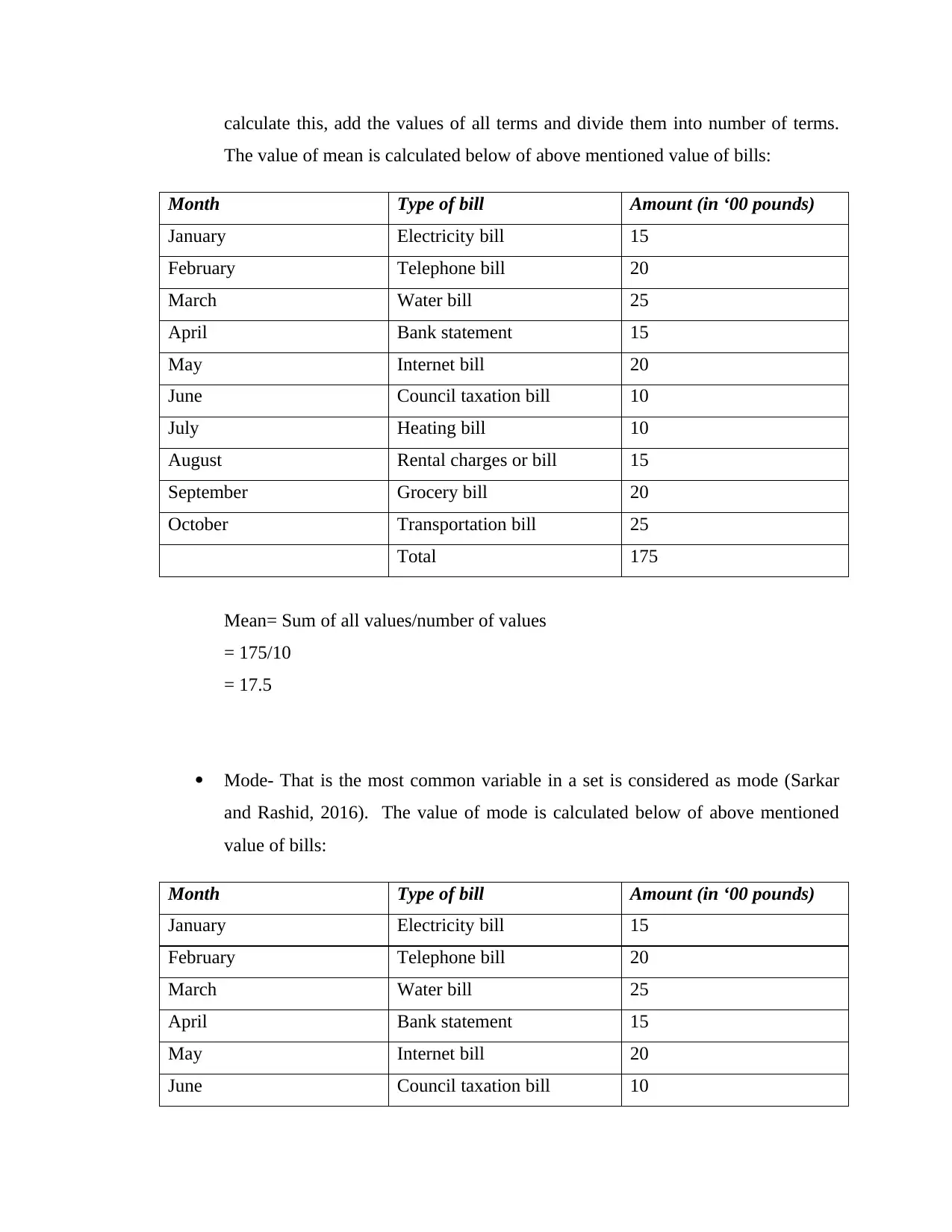
calculate this, add the values of all terms and divide them into number of terms.
The value of mean is calculated below of above mentioned value of bills:
Month Type of bill Amount (in ‘00 pounds)
January Electricity bill 15
February Telephone bill 20
March Water bill 25
April Bank statement 15
May Internet bill 20
June Council taxation bill 10
July Heating bill 10
August Rental charges or bill 15
September Grocery bill 20
October Transportation bill 25
Total 175
Mean= Sum of all values/number of values
= 175/10
= 17.5
Mode- That is the most common variable in a set is considered as mode (Sarkar
and Rashid, 2016). The value of mode is calculated below of above mentioned
value of bills:
Month Type of bill Amount (in ‘00 pounds)
January Electricity bill 15
February Telephone bill 20
March Water bill 25
April Bank statement 15
May Internet bill 20
June Council taxation bill 10
The value of mean is calculated below of above mentioned value of bills:
Month Type of bill Amount (in ‘00 pounds)
January Electricity bill 15
February Telephone bill 20
March Water bill 25
April Bank statement 15
May Internet bill 20
June Council taxation bill 10
July Heating bill 10
August Rental charges or bill 15
September Grocery bill 20
October Transportation bill 25
Total 175
Mean= Sum of all values/number of values
= 175/10
= 17.5
Mode- That is the most common variable in a set is considered as mode (Sarkar
and Rashid, 2016). The value of mode is calculated below of above mentioned
value of bills:
Month Type of bill Amount (in ‘00 pounds)
January Electricity bill 15
February Telephone bill 20
March Water bill 25
April Bank statement 15
May Internet bill 20
June Council taxation bill 10

July Heating bill 10
August Rental charges or bill 15
September Grocery bill 20
October Transportation bill 25
Total 175
The term 15 has higher frequency thus, mode is 15.
Median- The "median" is the "center" value in the number sequence where no
number is repeated and there is no list variable. This is computed by a formula
that is as follows:
When data set is odd= (N+1)/2th item.
When data set is even= {N/2th item+ N/2th item + 1}2
In the above mentioned data set, this can be found out that data set is even so
median will be calculated as follows:
First of all, the data set needs to be arranged in ascending order:
Month Type of bill Amount (in ‘00
pounds)
January Electricity bill 10
February Telephone bill 10
March Water bill 15
April Bank statement 15
May Internet bill 15
June Council taxation bill 20
July Heating bill 20
August Rental charges or bill 20
September Grocery bill 25
October Transportation bill 25
Total
August Rental charges or bill 15
September Grocery bill 20
October Transportation bill 25
Total 175
The term 15 has higher frequency thus, mode is 15.
Median- The "median" is the "center" value in the number sequence where no
number is repeated and there is no list variable. This is computed by a formula
that is as follows:
When data set is odd= (N+1)/2th item.
When data set is even= {N/2th item+ N/2th item + 1}2
In the above mentioned data set, this can be found out that data set is even so
median will be calculated as follows:
First of all, the data set needs to be arranged in ascending order:
Month Type of bill Amount (in ‘00
pounds)
January Electricity bill 10
February Telephone bill 10
March Water bill 15
April Bank statement 15
May Internet bill 15
June Council taxation bill 20
July Heating bill 20
August Rental charges or bill 20
September Grocery bill 25
October Transportation bill 25
Total
Paraphrase This Document
Need a fresh take? Get an instant paraphrase of this document with our AI Paraphraser

N= 10
M= (10/2th item + 10/2th item + 1)/2
= (5th item+ 6th item)/2
= (15+20)/2
= 17.5
Range- It is defined as difference between higher value and lower value. The
value of range is calculated in such manner of above mentioned data set:
Higher value= 25
Lower value= 10
Range= 25-10
= 15
Standard deviation- : It is a statistic that is used to measure the distribution for the
population of medium or expected values (Leech, Barrett and Morgan, 2013). A
poor expectation is that most estimates fall below the norm. The numbers are
expressed more broadly by a high standard deviation. This is calculated in such
manner:
Month Type of bill Amou
nt (in
‘00
pound
s)
x-m (x-
m) 2
January Electricity
bill
15
-2.5 6.25
February Telephone
bill
20
2.5 6.25
M= (10/2th item + 10/2th item + 1)/2
= (5th item+ 6th item)/2
= (15+20)/2
= 17.5
Range- It is defined as difference between higher value and lower value. The
value of range is calculated in such manner of above mentioned data set:
Higher value= 25
Lower value= 10
Range= 25-10
= 15
Standard deviation- : It is a statistic that is used to measure the distribution for the
population of medium or expected values (Leech, Barrett and Morgan, 2013). A
poor expectation is that most estimates fall below the norm. The numbers are
expressed more broadly by a high standard deviation. This is calculated in such
manner:
Month Type of bill Amou
nt (in
‘00
pound
s)
x-m (x-
m) 2
January Electricity
bill
15
-2.5 6.25
February Telephone
bill
20
2.5 6.25
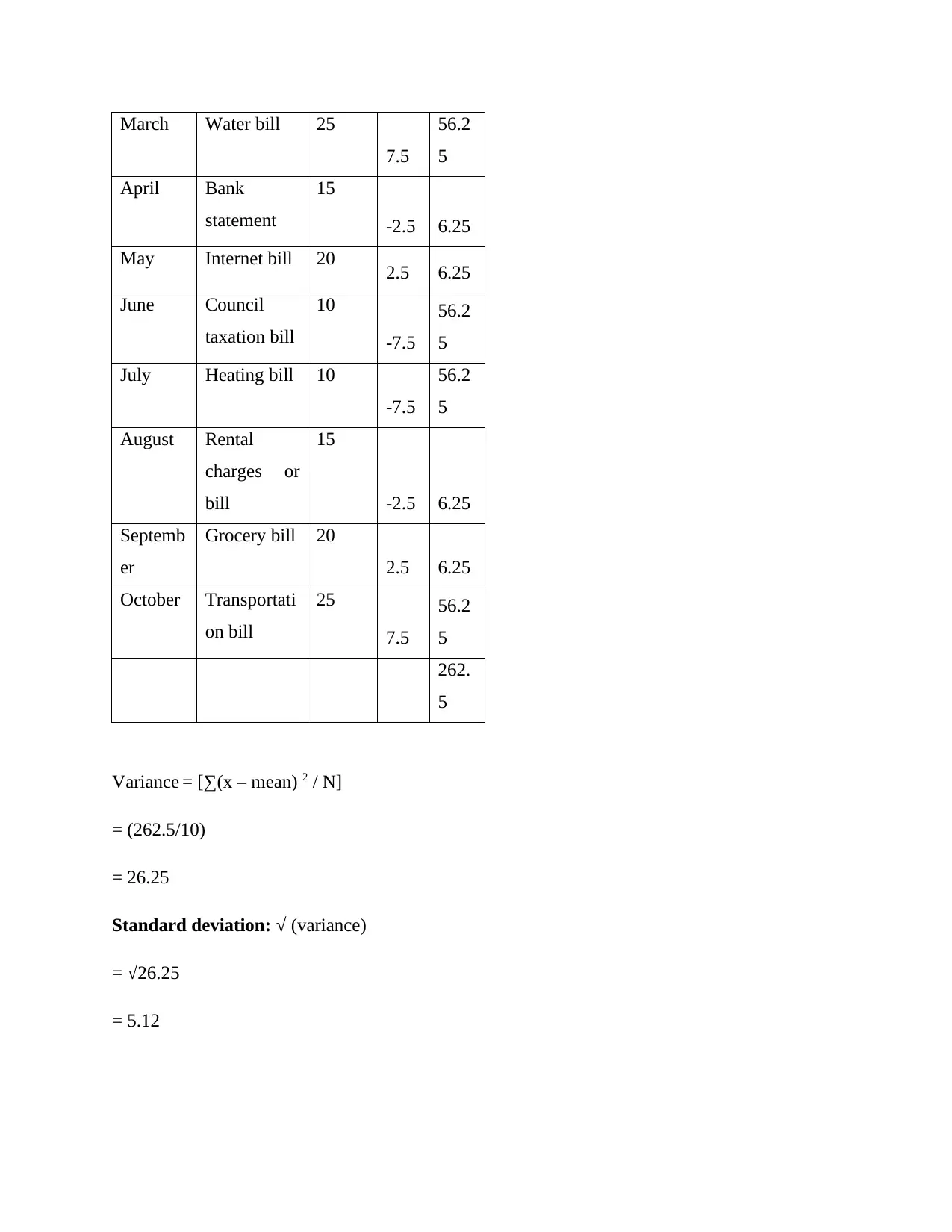
March Water bill 25
7.5
56.2
5
April Bank
statement
15
-2.5 6.25
May Internet bill 20 2.5 6.25
June Council
taxation bill
10
-7.5
56.2
5
July Heating bill 10
-7.5
56.2
5
August Rental
charges or
bill
15
-2.5 6.25
Septemb
er
Grocery bill 20
2.5 6.25
October Transportati
on bill
25
7.5
56.2
5
262.
5
Variance = [∑(x – mean) 2 / N]
= (262.5/10)
= 26.25
Standard deviation: √ (variance)
= √26.25
= 5.12
7.5
56.2
5
April Bank
statement
15
-2.5 6.25
May Internet bill 20 2.5 6.25
June Council
taxation bill
10
-7.5
56.2
5
July Heating bill 10
-7.5
56.2
5
August Rental
charges or
bill
15
-2.5 6.25
Septemb
er
Grocery bill 20
2.5 6.25
October Transportati
on bill
25
7.5
56.2
5
262.
5
Variance = [∑(x – mean) 2 / N]
= (262.5/10)
= 26.25
Standard deviation: √ (variance)
= √26.25
= 5.12
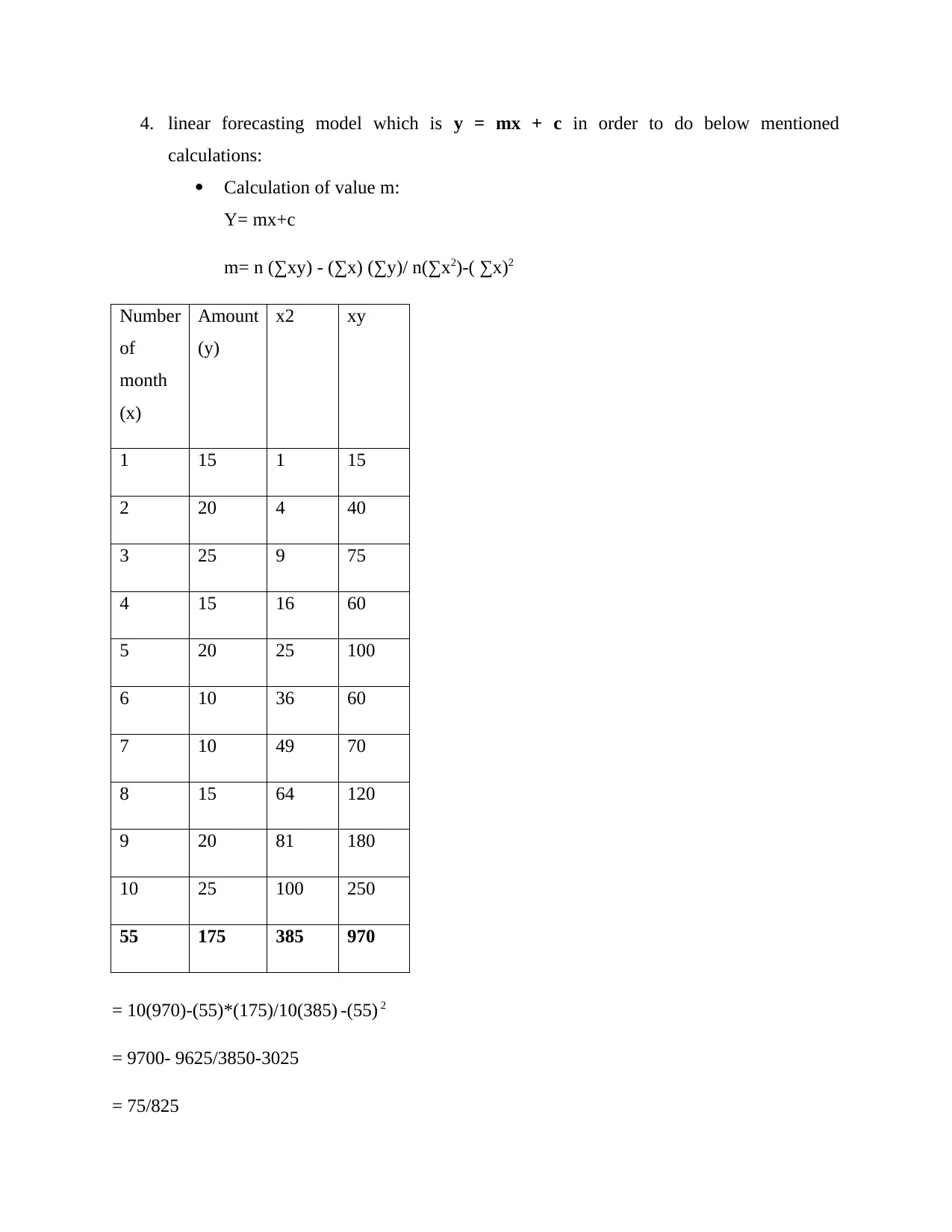
4. linear forecasting model which is y = mx + c in order to do below mentioned
calculations:
Calculation of value m:
Y= mx+c
m= n (∑xy) - (∑x) (∑y)/ n(∑x2)-( ∑x)2
Number
of
month
(x)
Amount
(y)
x2 xy
1 15 1 15
2 20 4 40
3 25 9 75
4 15 16 60
5 20 25 100
6 10 36 60
7 10 49 70
8 15 64 120
9 20 81 180
10 25 100 250
55 175 385 970
= 10(970)-(55)*(175)/10(385) -(55) 2
= 9700- 9625/3850-3025
= 75/825
calculations:
Calculation of value m:
Y= mx+c
m= n (∑xy) - (∑x) (∑y)/ n(∑x2)-( ∑x)2
Number
of
month
(x)
Amount
(y)
x2 xy
1 15 1 15
2 20 4 40
3 25 9 75
4 15 16 60
5 20 25 100
6 10 36 60
7 10 49 70
8 15 64 120
9 20 81 180
10 25 100 250
55 175 385 970
= 10(970)-(55)*(175)/10(385) -(55) 2
= 9700- 9625/3850-3025
= 75/825
Secure Best Marks with AI Grader
Need help grading? Try our AI Grader for instant feedback on your assignments.
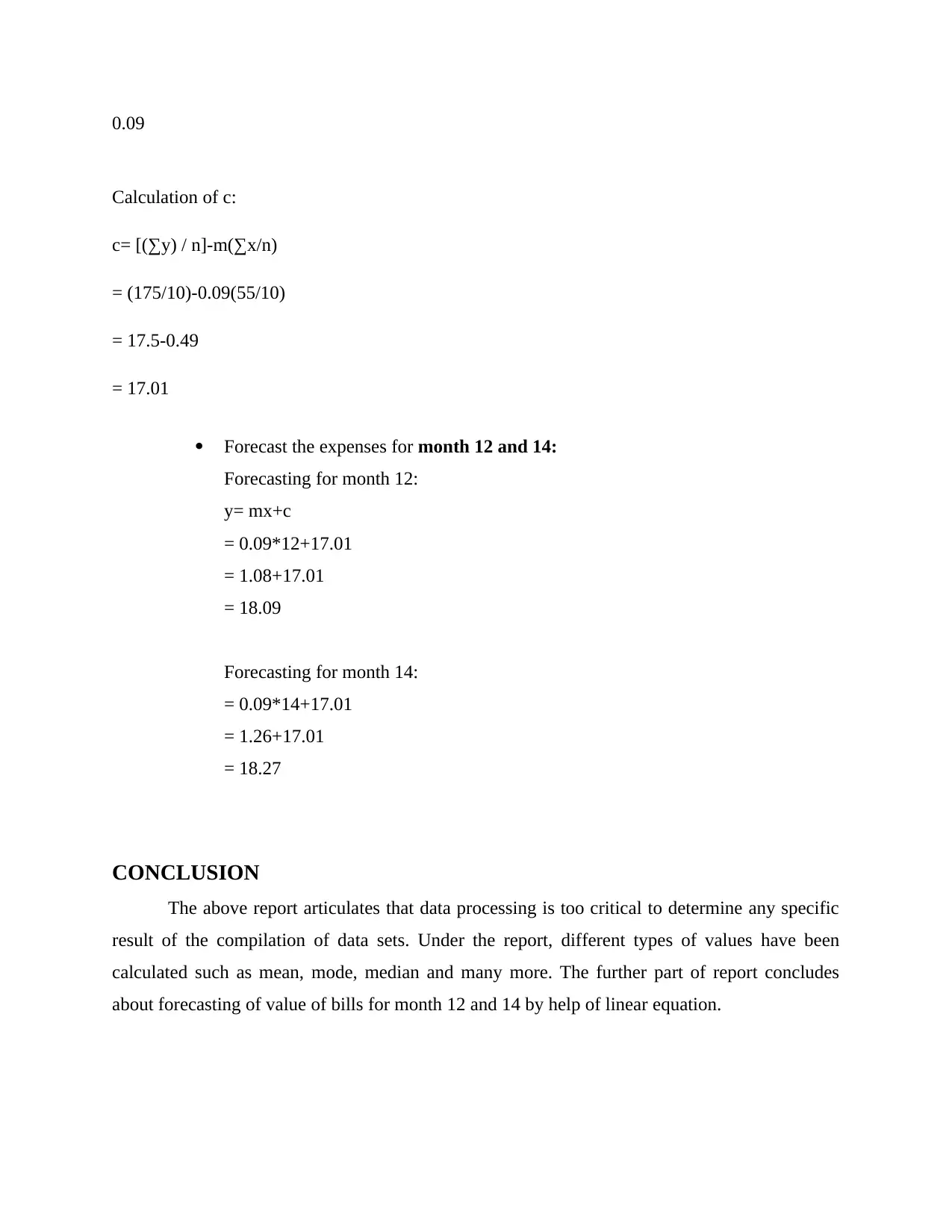
0.09
Calculation of c:
c= [(∑y) / n]-m(∑x/n)
= (175/10)-0.09(55/10)
= 17.5-0.49
= 17.01
Forecast the expenses for month 12 and 14:
Forecasting for month 12:
y= mx+c
= 0.09*12+17.01
= 1.08+17.01
= 18.09
Forecasting for month 14:
= 0.09*14+17.01
= 1.26+17.01
= 18.27
CONCLUSION
The above report articulates that data processing is too critical to determine any specific
result of the compilation of data sets. Under the report, different types of values have been
calculated such as mean, mode, median and many more. The further part of report concludes
about forecasting of value of bills for month 12 and 14 by help of linear equation.
Calculation of c:
c= [(∑y) / n]-m(∑x/n)
= (175/10)-0.09(55/10)
= 17.5-0.49
= 17.01
Forecast the expenses for month 12 and 14:
Forecasting for month 12:
y= mx+c
= 0.09*12+17.01
= 1.08+17.01
= 18.09
Forecasting for month 14:
= 0.09*14+17.01
= 1.26+17.01
= 18.27
CONCLUSION
The above report articulates that data processing is too critical to determine any specific
result of the compilation of data sets. Under the report, different types of values have been
calculated such as mean, mode, median and many more. The further part of report concludes
about forecasting of value of bills for month 12 and 14 by help of linear equation.
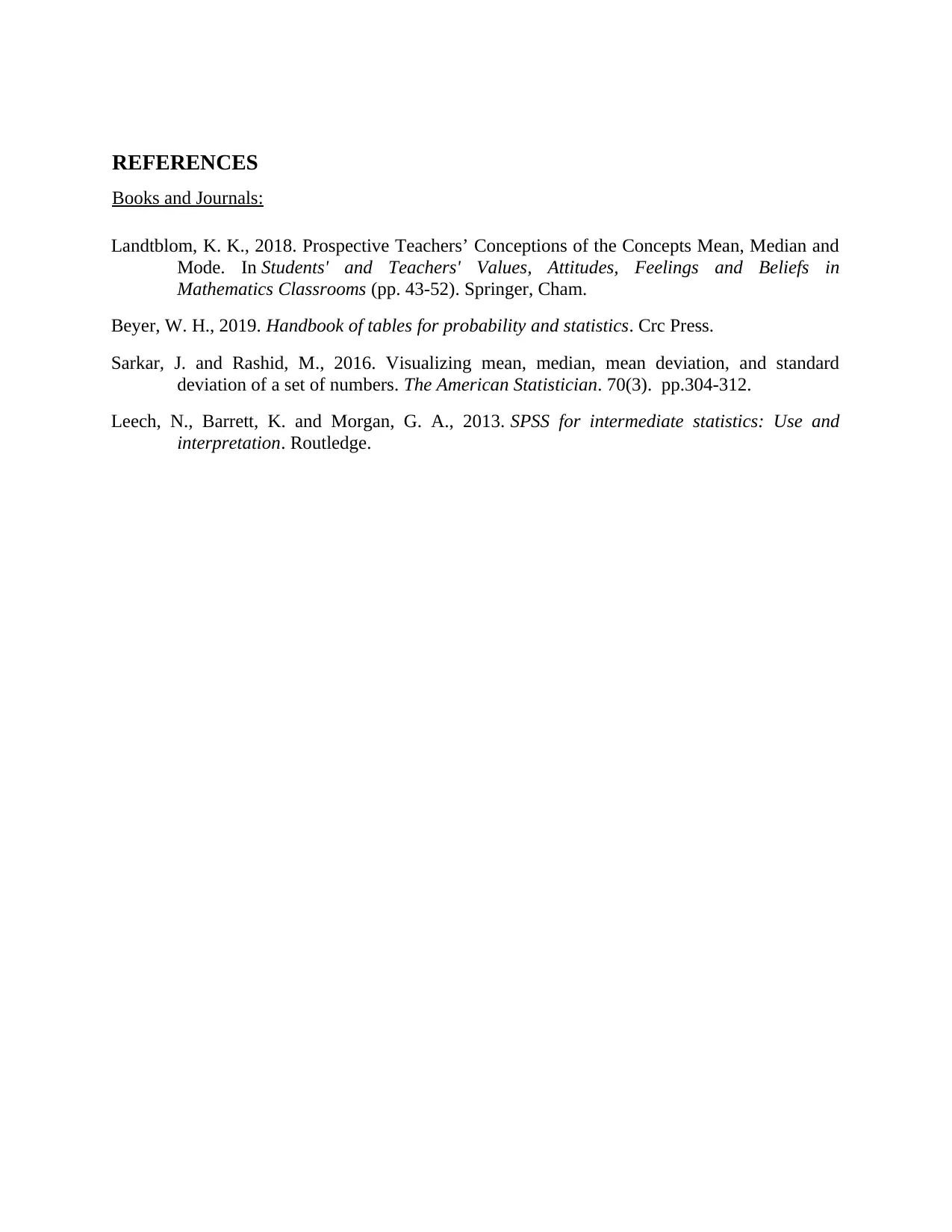
REFERENCES
Books and Journals:
Landtblom, K. K., 2018. Prospective Teachers’ Conceptions of the Concepts Mean, Median and
Mode. In Students' and Teachers' Values, Attitudes, Feelings and Beliefs in
Mathematics Classrooms (pp. 43-52). Springer, Cham.
Beyer, W. H., 2019. Handbook of tables for probability and statistics. Crc Press.
Sarkar, J. and Rashid, M., 2016. Visualizing mean, median, mean deviation, and standard
deviation of a set of numbers. The American Statistician. 70(3). pp.304-312.
Leech, N., Barrett, K. and Morgan, G. A., 2013. SPSS for intermediate statistics: Use and
interpretation. Routledge.
Books and Journals:
Landtblom, K. K., 2018. Prospective Teachers’ Conceptions of the Concepts Mean, Median and
Mode. In Students' and Teachers' Values, Attitudes, Feelings and Beliefs in
Mathematics Classrooms (pp. 43-52). Springer, Cham.
Beyer, W. H., 2019. Handbook of tables for probability and statistics. Crc Press.
Sarkar, J. and Rashid, M., 2016. Visualizing mean, median, mean deviation, and standard
deviation of a set of numbers. The American Statistician. 70(3). pp.304-312.
Leech, N., Barrett, K. and Morgan, G. A., 2013. SPSS for intermediate statistics: Use and
interpretation. Routledge.
1 out of 12
Related Documents
Your All-in-One AI-Powered Toolkit for Academic Success.
+13062052269
info@desklib.com
Available 24*7 on WhatsApp / Email
![[object Object]](/_next/static/media/star-bottom.7253800d.svg)
Unlock your academic potential
© 2024 | Zucol Services PVT LTD | All rights reserved.



